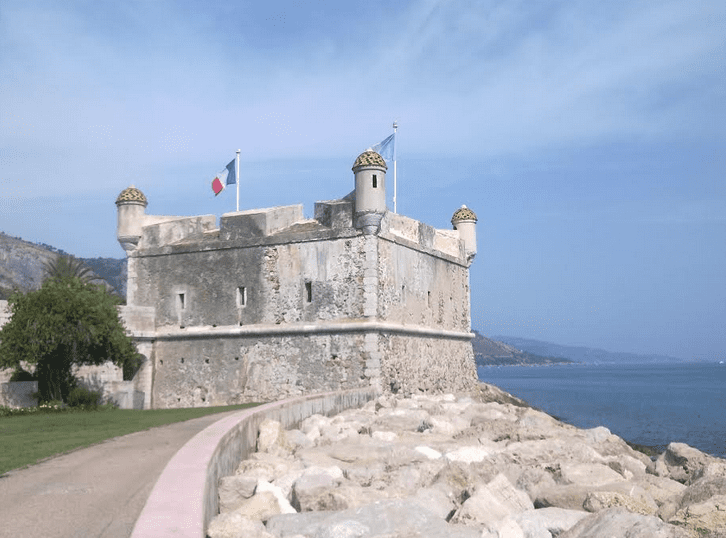At the beginning of the seventeenth century Onorato (Honoré) I was officially the head of state but he was still far too young. Monaco was ruled by his uncle Federico Landi as governor. Onorato grew up with his two sisters in the country of his late mother, Val di Taro (a small Principality near Parma). There he received a protected education in which there was also a lot of attention to the arts and literature. He then went on to study and live in Milan. He had himself addressed as a Prince to impress his friends at the university. Not much later he even received permission from King Philip IV to officially bear the title of Prince when he returned to Monaco as an adult. The land by the sea had become a Principality.
Onorato officially became the first Prince of Monaco in 1616. With this honorable title he wanted to radiate more power and also oppose Spain because he found it incomprehensible that the Spanish soldiers could not have prevented the attack on his father. He started to behave more and more independently and was allowed to let Monaco mint its own currency. He married Ippolita Trivulzio, a daughter of a count from Milan, in the same year.
Onorato ruled his country as an absolute monarch but turned out to be above all a Prince with a world outlook. He took care of a renovation of the Palace and organised many parties. He attracted artists to make the palace look even more beautiful. He purchased many works of art. During his reign, Menton was also enriched with some striking buildings, such as the St. Michel church with the cheerful campanile and basilica.
Spain’s influence on life in Monaco remained strong. The presence of Spanish soldiers in the port still resembled an occupation. That is why Onorato occasionally tried to get out from under the Spanish yoke. He secretly contacted the French Cardinal Richelieu, who was the most powerful politician at the French court at the time. Of course, King Louis XIII was delighted with this rapprochement by the Prince, who patiently waited for the moment to make the switch.

On September 14, 1641, the two heads of state signed the treaty of Péronne. Monaco came under French protection. Onorato dropped Spain in favour of France. Prince Rainier III later called this “the bravest act in the history of my dynasty”. Incidentally, Monaco did not border France at that time.
Louis XIII also recognized Monaco as an independent country and offered it protection, in exchange for five hundred French soldiers seconded to the port at the King’s expense. In addition, the Prince received a stipend from the king of 75,000 pounds. Louis XIII said theatrically to Onorato after the signing of the treaty: “You will never regret your choice and you will immediately see the difference between us and the Spaniards.” On November 17, 1641, the Spanish soldiers were brutally driven out after an intervention by the French fleet, much to the enthusiasm of the Monegasques.
Louis XIII arranged a special reception for the Prince in Perpignan, where he stayed because of the war against Spain. The ties between the French and Monegasque courts would become very close. The Prince spent more and more time in Paris and at the court of Versailles. His son Hercule (Ercole) was also at the meeting in Perpignan. On that occasion the king gave him a diamond necklace as a present for his wife-to-be, Maria Aurelia Spinola, a daughter of a wealthy and powerful family from Genoa. As a tribute to the friendship, Hercule would name his eldest son Louis (Ludovico). Louis XIV would in turn become the godfather of this Louis.
However, Hercule would never come to the throne because eight years later he died as a result of a remarkable incident. He was a spectator at a shooting practice by soldiers in the garden of the palace at Carnolès (Menton) on August 2, 1651. He was accidentally hit in the back and immediately knew he wouldn’t survive. On his deathbed, he asked forgiveness for his killer, who had been immediately put in prison and had even attempted suicide. The killer was released and left Monaco. Hercule’s son Louis was only ten months old.
While his grandfather ruled Monaco, Louis spent much time at the French court at Versailles because he was specially protected by the King. He became very close friends with Louis XIV, who was also his godfather. Louis became a true ‘French’ prince of Monaco and got the nickname ‘the Monegasque Sun King’ in the annals. He was also the first in his dynasty to marry a French woman: Charlotte-Cathérine de Gramont. The marriage was made through the intercession of Louis XIV, who instructed Mazarin to find a good partner for his friend. The cardinal introduced this daughter of a marshal to the Prince. She was a striking presence, with blonde hair. She became one of the most beautiful women at the court at Versailles, a true Parisienne, who had grown up a stone’s throw from the Louvre. There the marriage contract was signed on 28 April 1659 by Louis XIV. That’s how important this marriage was to the Sun King, apparently. The marriage took place on March 30,1660, in Pau, the city where her father was governor for the King. Louis XIV would marry two months later in nearby St. Jean de Luz. Charlotte understood the etiquette of life at court while Prince Louis made a peasant impression in Paris and Versailles.
Not everyone was happy with Louis’ marriage to the mundane Charlotte. His mother Aurelia Spinola was so displeased that she angrily retired to Genoa. It soon became clear that Monaco was far too small for Charlotte. She would hardly report to the rock, but she did take care of a new renovation of the Palace, including the monumental staircase with marble from Carrara.
Louis succeeded his deceased grandfather in 1662. Actually, Louis and Cathérine lived separately from each other from that moment on. She lived more at the French court and became one of the mistresses of the real Sun King. Louis still fought in the French army against the Netherlands and England, but still wanted to be in Monaco as much as possible. Charlotte had fulfilled a duty and given birth to five children. In 1672, the couple officially decided to divorce.
Crown-prince Antoine (Antonio) I was born during the lifetime of his great-grandfather Onorato, on 25 January, 1661. Charlotte died in Paris at the age of 39. Louis continued to do mainly diplomatic work for Louis XIV and had to negotiate on behalf of Louis XIV the French position in the Spanish succession when the Spanish King Carlos II died childless. Louis would negotiate with the Pope in Rome for two years and he would die in Rome on January 3, 1701, at the age of 58.
Monaco had entered a new century still as an independent country.
PHOTOS: Top, St. Michel Church in Menton, centre, the fort at Menton


